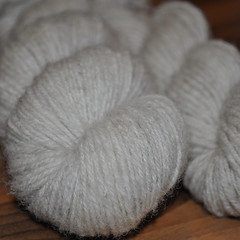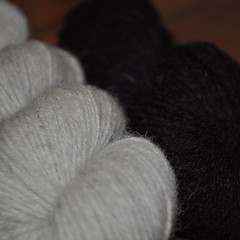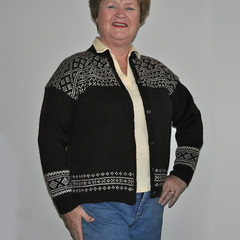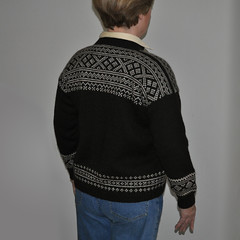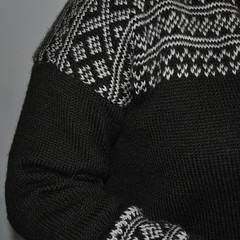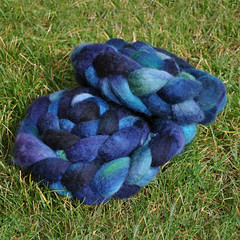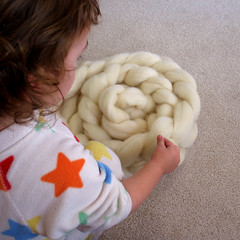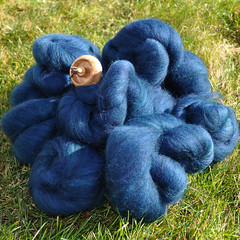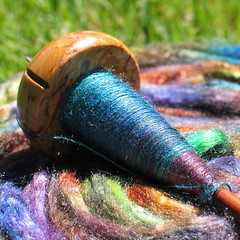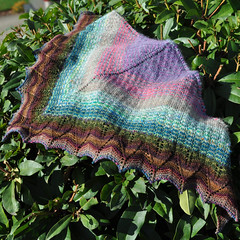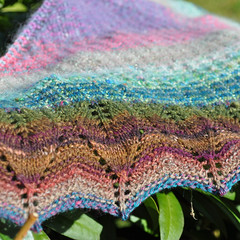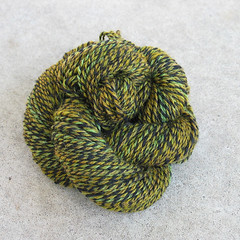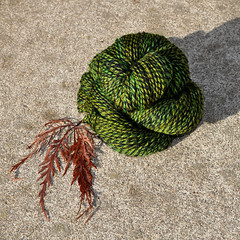This fiber is from a Jacob sheep. Actually, it's from two different Jacob sheep (a mother/daughter pair) owned by a friend of mine from our gym. My penchant for bringing in hand-knit and hand-spun goods prompted her to offer her fleeces to me this last Spring.
I'm afraid I'm rarely one to turn down "free". At the worst, I'm told icky fleece makes awesome mulch. At the best, you can get something amazing. And this, in my opinion, is as close to "the best" as you can get.
Jacob is considered an "unimproved" breed of sheep. Unlike Merino, they haven't gone through a huge amount of selective breeding. They have horns (2, 4, or 6, which go in every direction) and are sturdy sheep. Their wool is two-toned. white and brown/black. You may recall the 'splody sheep. This is those fleeces. They came back lovely and ready to spin. Now I've finally finished about six ounces of the fiber (three white and three brown). Since I spun two full ounces in the month of December, and the Spindler's Challenge theme is "Inspired by Music", this little skein kept me humming "White Christmas". Nothing else in my stash leaped out as a song, so I think that'll be appropriate for December!
I kept trying to spin fingering-weight yarn. I really did. I sampled and kept my single taped to a card for reference. But it always ended up drifting back to sport (maybe just from being nicely springy and fulling up in the wash when I finished). At any rate, I've found a lovely sport-weight pattern for it, and I'm ready to get started knitting very soon!
Sunday, December 27, 2009
Tuesday, December 22, 2009
Ravelry Voting
So, the Phat Fiber group is doing a little contest. There are lots of entries up here (it's a link to the Ravelry Forums, so you'll need a login to get there) and they are supposed to be anonymous. There is some pretty amazing spinning, knitting, crochet and felting up and it's fun to look through. Especially since the entire thread is just pictures and you don't have to wade through ANY chatter to enjoy the pretty.
But I'm in there (twice, once for the knitted object and once with the handspun to make it). Votes are made by clicking on the "love" button on the post.
I'd LOVE(1) it if you'd stop by and look. My entry "should" be obvious.. and I'd love it if you'd Love(1) that! And anything else that you love, of course.. but especially mine ;)
But I'm in there (twice, once for the knitted object and once with the handspun to make it). Votes are made by clicking on the "love" button on the post.
I'd LOVE(1) it if you'd stop by and look. My entry "should" be obvious.. and I'd love it if you'd Love(1) that! And anything else that you love, of course.. but especially mine ;)
Labels:
Not Necessarily Knitting
Saturday, December 19, 2009
Mom's re-shouldered sweater
To quote a friend, "Today I bring you The Rescued Sweater." To understand the full story behind this sweater, you must first go here. And when you're done reading there, come on back for the rest of the tale.
Now, before you close that window down, take a really good look at the shoulder. You can see in GeekKnitter's pictures that the cream color in the body and the cream color in the shoulder don't actually quite match. We tried this sweater on quite a few people and found that the arms were just plain old long. Despite that, my mother (who happened to be visiting at the time... lucky Mom!) loved this sweater. It really is beautiful and a work of art.
I devised a plan. I would (yikes!) separate the sleeves and (YEEEEK!) frog them back, re-knitting what needed to be replaced so that the arms would then be a proper length. If you are weak of heart, you might want to stop reading now.
RIBBIT! RIBBIT! RIBBIT! Yes. I really did. It was no easy task, either. First, I had to bring out my seam-ripper (a pronged tool that is slightly sharpened at the fork so as to allow you to sever sewing thread in a seam with ease--it also parts yarn and cloth with equal ease). I had to rip out the seam inside where the sleeve had been knit long enough to be sewn down over the top of the steeked mess around the armhole. It's a natural mess, but it had been covered up beautifully. After ripping that seam and revealing the mattress stitch within, I carefully picked THAT out and removed the sleeves. Then, I popped the cast-off edge and ... zip, zap, zoom... the top of the sleeves were gone.
About half way in on both sleeves, a new ball had been joined in the knitting (flawlessly, of course). So I took those balls of yarn and skeined them up. I skeined up what remained attached to the sleeve as well and then carefully dunked everything in a hot bath in my sink to get all the kinks out for re-knitting. I dryed and then re-wound a ball of the cream color. With this, I knit a swatch on three different size needles to make sure I would get proper gauge.
Needle sized determined, I returned to the sweater and knit it about half-way back from what I had ripped out. This still left them several inches shorter than their original length. But it gave me a chance to expand the sleeve back to a size that would fit the armscye, and make it the perfect length for Mom (we determined this by making her wear the remains of the sweater and snugged the arm up until it fit right).
As you can see, it came out wonderfully! I tried to put the same care in re-attaching the sleeve as the original creator, but I didn't do it quite the same way. I mattress-stitched the sleeve into each armscye carefully. And then I took the excess (I had knit myself some wiggle room) and I mattress stitched THAT down over the ragged edges of the steek. I'm afraid I'm not a good enough hand with a sewing machine to trust myself to seam down the edge that way. But I know my hand-seaming skills and they were up to the task.
Here's a final look at the new shoulder. It looks snazzy. So does Mom. And now everyone is thrilled that this rescue project has come to a close. Mom says it's deliriously warm. That should serve her quite well for the chilly Winter she'll "enjoy". And I get to warm up with the knowledge that I did a good job putting things back together again.
Now, before you close that window down, take a really good look at the shoulder. You can see in GeekKnitter's pictures that the cream color in the body and the cream color in the shoulder don't actually quite match. We tried this sweater on quite a few people and found that the arms were just plain old long. Despite that, my mother (who happened to be visiting at the time... lucky Mom!) loved this sweater. It really is beautiful and a work of art.
I devised a plan. I would (yikes!) separate the sleeves and (YEEEEK!) frog them back, re-knitting what needed to be replaced so that the arms would then be a proper length. If you are weak of heart, you might want to stop reading now.
RIBBIT! RIBBIT! RIBBIT! Yes. I really did. It was no easy task, either. First, I had to bring out my seam-ripper (a pronged tool that is slightly sharpened at the fork so as to allow you to sever sewing thread in a seam with ease--it also parts yarn and cloth with equal ease). I had to rip out the seam inside where the sleeve had been knit long enough to be sewn down over the top of the steeked mess around the armhole. It's a natural mess, but it had been covered up beautifully. After ripping that seam and revealing the mattress stitch within, I carefully picked THAT out and removed the sleeves. Then, I popped the cast-off edge and ... zip, zap, zoom... the top of the sleeves were gone.
About half way in on both sleeves, a new ball had been joined in the knitting (flawlessly, of course). So I took those balls of yarn and skeined them up. I skeined up what remained attached to the sleeve as well and then carefully dunked everything in a hot bath in my sink to get all the kinks out for re-knitting. I dryed and then re-wound a ball of the cream color. With this, I knit a swatch on three different size needles to make sure I would get proper gauge.
Needle sized determined, I returned to the sweater and knit it about half-way back from what I had ripped out. This still left them several inches shorter than their original length. But it gave me a chance to expand the sleeve back to a size that would fit the armscye, and make it the perfect length for Mom (we determined this by making her wear the remains of the sweater and snugged the arm up until it fit right).
As you can see, it came out wonderfully! I tried to put the same care in re-attaching the sleeve as the original creator, but I didn't do it quite the same way. I mattress-stitched the sleeve into each armscye carefully. And then I took the excess (I had knit myself some wiggle room) and I mattress stitched THAT down over the ragged edges of the steek. I'm afraid I'm not a good enough hand with a sewing machine to trust myself to seam down the edge that way. But I know my hand-seaming skills and they were up to the task.
Here's a final look at the new shoulder. It looks snazzy. So does Mom. And now everyone is thrilled that this rescue project has come to a close. Mom says it's deliriously warm. That should serve her quite well for the chilly Winter she'll "enjoy". And I get to warm up with the knowledge that I did a good job putting things back together again.
Labels:
Designing,
Not Necessarily Knitting,
Odds and Ends,
Sweater
Thursday, December 17, 2009
When good fiber goes bad... or good...
Doesn't this look pretty? This is eight ounces (that's a half pound, or easily enough for two and maybe three pairs of socks) of Blue-faced Leicester commercially combed top. This was once a very plain white braid of fiber to which I applied dye, vinegar, and heat one muggy summer evening. What it produced was lovely to look at, but almost impossible to spin.
Here is the top in its original, pristine state. It's beautiful (as you can tell by my son admiring it back in March of 2009...back before we sheared off his curls!). BFL is a really lovely fiber. It is a longer staple fiber than merino, but can be almost as soft. It is considered to be harder-wearing and excellent for use in socks. I purchased it when I was just getting into the craft of spinning and really had no idea how I would use it, but it was considered an excellent "beginners fiber".
It marinated in my stash until later in the summer I had a few spare moments to dye. I processed the full eight ounces just as I had the smaller braids of Merino I had practiced on earlier. The colors came out nearly as I intended. But what I did not contend with was my own impatience. My efforts to rinse the over-saturated fiber clean resulted in compacting the top and slightly felting the fibers. It was not un-salvageable. But it was going to require stripping the top down and pre-drafting it until everything came loose enough again to work.
If I was going to do all that, I figured, I might as well drum-card the batch! I knew that the Eugene Textile Center would rent out their drum-carder for a full or half-day. And when I went in to use it, the informed me I could also take it home for a daily rate. Using the carder in-store is a juggling act of coordinating schedules. Using the drum-carder at home only requires naptime. Hurray for me!
So what I was able to obtain out of all this are twelve batts, each approximately 3/4 ounce (the most I could get onto the carder without a packing brush). To get this I broke my roving into tiny pieces and jumbled them all together. I created eight batts from the first half of the roving and eight from the second (I got better at packing as I had more practice through the day). I took all these and stacked them every-other one and then divided them in half lengthwise. I took chunks from these batts and re-carded them. And then I did the whole thing a third time, ending with twelve very smooth, well-blended batts. The depth of color does not fully present itself in the picture.
I've started to spin the first one recently and it is lovely. It isn't perfect (but I didn't expect perfection). But I did well listening to all the advice I could before-hand. I didn't over-load the licker-in. I cranked VERY slowly to allow all the fibers to add in smoothly without breaking or turning into tangled nepps. And it worked!
This project does not exist in a complete vacuum. I had decided that my dyed braid would be plied with silk I was already spinning and the resulting yarn would go into a design of my own creation. I think the carded single will pair even better with the silk and the sampling I have done so far yields a positively gorgeous yarn. It just may take me another year to finish it all!
Here is the top in its original, pristine state. It's beautiful (as you can tell by my son admiring it back in March of 2009...back before we sheared off his curls!). BFL is a really lovely fiber. It is a longer staple fiber than merino, but can be almost as soft. It is considered to be harder-wearing and excellent for use in socks. I purchased it when I was just getting into the craft of spinning and really had no idea how I would use it, but it was considered an excellent "beginners fiber".
It marinated in my stash until later in the summer I had a few spare moments to dye. I processed the full eight ounces just as I had the smaller braids of Merino I had practiced on earlier. The colors came out nearly as I intended. But what I did not contend with was my own impatience. My efforts to rinse the over-saturated fiber clean resulted in compacting the top and slightly felting the fibers. It was not un-salvageable. But it was going to require stripping the top down and pre-drafting it until everything came loose enough again to work.
If I was going to do all that, I figured, I might as well drum-card the batch! I knew that the Eugene Textile Center would rent out their drum-carder for a full or half-day. And when I went in to use it, the informed me I could also take it home for a daily rate. Using the carder in-store is a juggling act of coordinating schedules. Using the drum-carder at home only requires naptime. Hurray for me!
So what I was able to obtain out of all this are twelve batts, each approximately 3/4 ounce (the most I could get onto the carder without a packing brush). To get this I broke my roving into tiny pieces and jumbled them all together. I created eight batts from the first half of the roving and eight from the second (I got better at packing as I had more practice through the day). I took all these and stacked them every-other one and then divided them in half lengthwise. I took chunks from these batts and re-carded them. And then I did the whole thing a third time, ending with twelve very smooth, well-blended batts. The depth of color does not fully present itself in the picture.
I've started to spin the first one recently and it is lovely. It isn't perfect (but I didn't expect perfection). But I did well listening to all the advice I could before-hand. I didn't over-load the licker-in. I cranked VERY slowly to allow all the fibers to add in smoothly without breaking or turning into tangled nepps. And it worked!
This project does not exist in a complete vacuum. I had decided that my dyed braid would be plied with silk I was already spinning and the resulting yarn would go into a design of my own creation. I think the carded single will pair even better with the silk and the sampling I have done so far yields a positively gorgeous yarn. It just may take me another year to finish it all!
Tuesday, December 15, 2009
Phat Ulmus
There comes a time when you look in your drawer full of those lovely samples of fiber you JUST COULDN'T RESIST and wonder... what the heck do I do with all this yarn? There's not enough of any one thing to make something out of unless you're into knit jewelry or ear-warmers. But there is enough, combined, to make something lovely if you put your mind to it.
Enter the Ulmus (Ravelry link). Ulmus is a lovely little shawl pattern originally written for two skeins of sock yarn, knit in alternating rows. It is somewhat reminiscent of the ubiquitous Noro Striped Scarf or at least I thought it could be. If managed right, my samples would provide the slow march of color that Noro would normally perform, and work out wonderfully in this shawlette. Ulmus also sports a beautifully subtle pattern of slipped stitches, which I hoped would blend the color changes a bit more.
Happily it worked! I had originally thought to try and make a shawl with a more subtle color progression from one end to the other, but I don't know what sparked the idea of striping. It was serendipity that let one color or another run out early, so the transitions between one type of sample to the next were concealed in the stripes of the other color which remained constant.
Of course, I couldn't just wing it and let it go. I knit most of the way to the end and looked over my work and just did not like the way the colors stripped through the leaf-lace border at all! I very carefully frogged back 15 or 20 rows (I lost count) -- and at the end of a shawl, let me tell you, even five rows is nothing to scoff at ripping back. And I re-arranged the order of the final samples so they blended gently into each other.
I am so very pleased with the final product! Not only was it a joy to knit with my handspun, but I was able to revisit each sample and enjoy again the process of making them and the beauty that each individual Phattie (as the contributors are called) provided! This has become my go-to garment to keep off the encroaching chill. It's wonderful to toss around my neck no matter what else I'm wearing. And with so many colors it is sure to coordinate somehow.
I can't wait to figure out what to do with some of my other bits and pieces!
Enter the Ulmus (Ravelry link). Ulmus is a lovely little shawl pattern originally written for two skeins of sock yarn, knit in alternating rows. It is somewhat reminiscent of the ubiquitous Noro Striped Scarf or at least I thought it could be. If managed right, my samples would provide the slow march of color that Noro would normally perform, and work out wonderfully in this shawlette. Ulmus also sports a beautifully subtle pattern of slipped stitches, which I hoped would blend the color changes a bit more.
Happily it worked! I had originally thought to try and make a shawl with a more subtle color progression from one end to the other, but I don't know what sparked the idea of striping. It was serendipity that let one color or another run out early, so the transitions between one type of sample to the next were concealed in the stripes of the other color which remained constant.
Of course, I couldn't just wing it and let it go. I knit most of the way to the end and looked over my work and just did not like the way the colors stripped through the leaf-lace border at all! I very carefully frogged back 15 or 20 rows (I lost count) -- and at the end of a shawl, let me tell you, even five rows is nothing to scoff at ripping back. And I re-arranged the order of the final samples so they blended gently into each other.
I am so very pleased with the final product! Not only was it a joy to knit with my handspun, but I was able to revisit each sample and enjoy again the process of making them and the beauty that each individual Phattie (as the contributors are called) provided! This has become my go-to garment to keep off the encroaching chill. It's wonderful to toss around my neck no matter what else I'm wearing. And with so many colors it is sure to coordinate somehow.
I can't wait to figure out what to do with some of my other bits and pieces!
Labels:
Designing,
Knitting,
Phat Fiber,
Spindle,
Spinning
Sunday, December 13, 2009
Can you tell the difference?
One of the little things I've dug out lately was some of the yarn I have on hand, but really need to re-purpose. There's nothing intrinsically wrong with the yarn itself, it just isn't exactly to my taste.
Take this lovely skein of hand-spun yarn. It is three-ply, spun on my spindle. It's very nicely even work (if I have to say so myself). But I'm not particularly a fan of the marled effect. And I particularly don't like how yellow the green is.
Enter my stock of Jacquard acid dyes.
I haven't done much dying so far. I played around with it a little with several batches of Merino top, and with eight ounces of BFL (which ended up hopelessly compacted, but that's a different story). Yarn is MUCH more simple to dye. Pre-soak yarn so it's wet. Drop it in a pot with some dye and add heat and acid and VIOLA! you have dyed yarn. There is some small risk of felt occurring, but it is significantly smaller (and less disastrous) than creating an unusable mass of unspun wool.
I didn't even measure. I tossed this skein in a Pyrex dish dedicated to the purpose, put in a glug of vinegar and a glug of "Emerald" dye stock, and tossed it in my "dying microwave" in the garage for 15min on 50%. Come back, and there is exhausted dye solution, and a... well. It's a little greener skein of yarn. I think.
Do you?
Take this lovely skein of hand-spun yarn. It is three-ply, spun on my spindle. It's very nicely even work (if I have to say so myself). But I'm not particularly a fan of the marled effect. And I particularly don't like how yellow the green is.
Enter my stock of Jacquard acid dyes.
I haven't done much dying so far. I played around with it a little with several batches of Merino top, and with eight ounces of BFL (which ended up hopelessly compacted, but that's a different story). Yarn is MUCH more simple to dye. Pre-soak yarn so it's wet. Drop it in a pot with some dye and add heat and acid and VIOLA! you have dyed yarn. There is some small risk of felt occurring, but it is significantly smaller (and less disastrous) than creating an unusable mass of unspun wool.
I didn't even measure. I tossed this skein in a Pyrex dish dedicated to the purpose, put in a glug of vinegar and a glug of "Emerald" dye stock, and tossed it in my "dying microwave" in the garage for 15min on 50%. Come back, and there is exhausted dye solution, and a... well. It's a little greener skein of yarn. I think.
Do you?
Wednesday, December 9, 2009
Where did November go??
Time flies, and not just when you're having fun. When you pile two separate week (or more) familial visits into one month, and then mix in a two week husbandly absence, it's not too shocking that an entire month can disappear into a big black hole of, "Wha??".
Oh, I've gotten things done. Blogging is not one of those things. Neither is taking much in the way of pictures. Smack in the middle of more solo driving here at home and a camera that decided at random not to turn on anymore I'm a bit at a loss. I'm really hoping to share some of the interesting things I've been able to get done sometime soon, but I don't know exactly how quickly that will happen.
Until then, happy knitting to you all. And to all, a good night.
Oh, I've gotten things done. Blogging is not one of those things. Neither is taking much in the way of pictures. Smack in the middle of more solo driving here at home and a camera that decided at random not to turn on anymore I'm a bit at a loss. I'm really hoping to share some of the interesting things I've been able to get done sometime soon, but I don't know exactly how quickly that will happen.
Until then, happy knitting to you all. And to all, a good night.
Labels:
Not Necessarily Knitting
Subscribe to:
Comments (Atom)

